Contrasting Genetic Footprints among Saharan Olive Populations: Potential Causes and Conservation Implications
Abstract
1. Introduction
2. Material and Methods
2.1. Plant Material
2.2. Genetic Markers
2.3. Data Analyses
2.3.1. Analyses of Nuclear Gene Sequences
2.3.2. Analyses of Plastid DNA Haplotypes
2.3.3. Descriptive Analyses of Population Genetic Data
2.3.4. Identification of Genetic Clusters
2.3.5. Gene Flow Patterns at Different Geographical Scales
3. Results
3.1. Nuclear Gene Diversity in the Laperrine’s Olive
3.2. Nuclear Microsatellite Polymorphism among the Four Massifs
3.3. Plastid DNA Polymorphism and Geographic Distribution of Chlorotypes
3.4. Pattern of Genetic Differentiation and Isolation by Distance
3.4.1. Genetic Differentiation between Massifs
3.4.2. Isolation by Distance
3.4.3. Pollen vs. Seed Flow
4. Discussion
4.1. Low Nucleotide Diversity in Nuclear Genes of the Laperrine’s Olive
4.2. Is Ahaggar a Long-Lasting Region for Laperrine’s Olive Survival?
4.3. Contrasting Patterns of Isolation by Distance among Massifs, Spatial Scales and Genomes
5. Conclusions
Supplementary Materials
Author Contributions
Funding
Data Availability Statement
Acknowledgments
Conflicts of Interest
References
- Schuster, M.; Duringer, P.; Ghienne, J.F.; Vignaud, P.; Mackaye, H.T.; Likius, A.; Brunet, M. The age of the Sahara desert. Science 2006, 311, 821. [Google Scholar] [CrossRef]
- Douady, C.J.; Catzeflis, F.; Raman, J.; Springer, M.S.; Stanhope, M.J. The Sahara as a vicariant agent, and the role of Miocene climatic events, in the diversification of the mammalian order Macroscelidea (elephant shrews). Proc. Natl. Acad. Sci. USA 2003, 100, 8325–8330. [Google Scholar] [CrossRef]
- Médail, F.; Quézel, P. Biogéographie de la Flore du Sahara: Une Biodiversité en Situation Extrême; IRD Editions: Geneva, Switzerland, 2018. [Google Scholar]
- Watrin, J.; Lézine, A.M.; Hély, C. Plant migration and plant communities at the time of the “Green Sahara”. C. R. Geosci. 2009, 341, 656–670. [Google Scholar] [CrossRef]
- Gasse, F.; Téhet, R.; Durand, A.; Gibert, E.; Fontes, J.C. The arid–humid transition in the Sahara and the Sahel during the last deglaciation. Nature 1990, 346, 141–146. [Google Scholar] [CrossRef]
- Petit-Maire, N. Sahara: Sous le Sable...des Lacs. Un Voyage Dans le Temps; CNRS Editions: Paris, France, 2002. [Google Scholar]
- Quézel, P. La Végétation du Sahara. Du Tchad à la Mauritanie; Gustav Fisher Verlag: Stuttgart, Germany, 1965. [Google Scholar]
- Migliore, J.; Baumel, A.; Juin, M.; Fady, B.; Roig, A.; Duong, N.; Médail, F. Surviving in mountain climate refugia: New insights from the genetic diversity and structure of the relict shrub Myrtus nivellei (Myrtaceae) in the Sahara desert. PLoS ONE 2013, 8, e73795. [Google Scholar] [CrossRef][Green Version]
- Abdoun, F.; Beddiaf, M. Cupressus dupreziana A. Camus: Répartition, dépérissement et régénération au Tassili n’Ajjer, Sahara central. C. R. Biol. 2002, 325, 617–627. [Google Scholar] [CrossRef]
- Migliore, J.; Baumel, A.; Juin, M.; Médail, F. From Mediterranean shores to central Saharan mountains: Key phylogeographical insights from the genus Myrtus. J. Biogeogr. 2012, 39, 942–956. [Google Scholar] [CrossRef]
- Besnard, G.; Anthelme, F.; Baali-Cherif, D. The Laperrine’s olive tree (Oleaceae): A wild genetic resource of the cultivated olive and a model-species for studying the biogeography of the Saharan Mountains. Acta Bot. Gallica 2012, 159, 319–328. [Google Scholar] [CrossRef]
- Lábusová, J.; Konrádová, H.; Lipavská, H. The endangered Saharan cypress (Cupressus dupreziana): Do not let it get into Charon’s boat. Planta 2020, 251, 63. [Google Scholar] [CrossRef] [PubMed]
- Battandier, J.B.; Trabut, L. Contribution à la flore du pays des Touaregs. Bull. Soc. Bot. Fr. 1911, 58, 669–677. [Google Scholar] [CrossRef]
- Angiolillo, A.; Mencuccini, M.; Baldoni, L. Olive genetic diversity assessed using amplified fragment length polymorphisms. Theor. Appl. Genet. 1999, 98, 411–421. [Google Scholar] [CrossRef]
- Rubio de Casas, R.; Besnard, G.; Schöenswetter, P.; Balaguer, L.; Vargas, P. Extensive gene flow blurs phylogeographic but not phylogenetic signal in Olea europaea L. Theor. Appl. Genet. 2006, 113, 575–583. [Google Scholar] [CrossRef]
- Besnard, G.; Rubio de Casas, R.; Vargas, P. Plastid and nuclear DNA polymorphism reveals historical processes of isolation and reticulation in the olive tree complex (Olea europaea). J. Biogeogr. 2007, 34, 736–752. [Google Scholar] [CrossRef]
- Wickens, G.E. The flora of Jebel Marra (Sudan) and its geographical affinities. Kew Bull. Add. Ser. 1976, 5, 1–368. [Google Scholar]
- Green, P.S. A revision of Olea L. (Oleaceae). Kew Bull. 2002, 57, 91–140. [Google Scholar] [CrossRef]
- Médail, F.; Quézel, P.; Besnard, G.; Khadari, B. Systematics, ecology and phylogeographic significance of Olea europaea L. subsp. maroccana (Greuter & Burdet) P. Vargas et al a relictual olive tree in south-west Morocco. Bot. J. Linn. Soc. 2001, 137, 249–266. [Google Scholar]
- Anthelme, F.; Abdoulkader, A.; Besnard, G. Distribution, shape and clonal growth of the rare endemic tree Olea europaea subsp. laperrinei (Oleaceae) in the Saharan mountains of Niger. Plant Ecol. 2008, 198, 73–87. [Google Scholar] [CrossRef][Green Version]
- Giazzi, F.; de Boissieu, D.; Waziri Mato, M.; Anthelme, F. Dégradation des ressources végétales au contact des activités humaines et perspectives de conservation dans le massif de l’Aïr (Sahara, Niger). VertigO 2006, 7. [Google Scholar] [CrossRef]
- Baali-Cherif, D.; Besnard, G. High genetic diversity and clonal growth in relict populations of Olea europaea subsp. laperrinei (Oleaceae) from Hoggar, Algeria. Ann. Bot. 2005, 96, 823–830. [Google Scholar] [CrossRef] [PubMed]
- Besnard, G.; Christin, P.A.; Baali-Cherif, D.; Bouguedoura, N.; Anthelme, F. Spatial genetic structure in the Laperrine’s olive (Olea europaea subsp. laperrinei), a long-living tree from central-Saharan mountains. Heredity 2007, 99, 649–657. [Google Scholar] [CrossRef][Green Version]
- Besnard, G.; Hernández, P.; Khadari, B.; Dorado, G.; Savolainen, V. Genomic profiling of plastid DNA variation in the Mediterranean olive tree. BMC Plant Biol. 2011, 11, 80. [Google Scholar] [CrossRef] [PubMed]
- García-Verdugo, C.; Forrest, A.D.; Fay, M.F.; Vargas, P. The relevance of gene flow in metapopulation dynamics of an oceanic island endemic, Olea europaea subsp. guanchica. Evolution 2010, 64, 3525–3536. [Google Scholar] [CrossRef]
- Ennos, R.A. Estimating the relative rates of pollen and seed migration among plant-populations. Heredity 1994, 72, 250–259. [Google Scholar] [CrossRef]
- Besnard, G.; Baali-Cherif, D.; Bettinelli-Riccardi, S.; Parietti, D.; Bouguedoura, N. Pollen-mediated gene flow in a highly fragmented landscape: Consequences for defining a conservation strategy of the relict Laperrine’s olive. C. R. Biol. 2009, 332, 662–672. [Google Scholar] [CrossRef]
- Beghè, D.; Piotti, A.; Satovic, Z.; de la Rosa, R.; Belaj, A. Pollen-mediated gene flow and fine-scale spatial genetic structure in Olea europaea subsp. europaea var. sylvestris. Ann. Bot. 2017, 119, 671–679. [Google Scholar]
- Kassa, A.; Konrad, H.; Geburek, T. Mating pattern and pollen dispersal in the wild olive tree (Olea europaea subsp. cuspidata). Tree Genet. Genomes 2018, 14, 3. [Google Scholar] [CrossRef]
- Besnard, G.; Rubio de Casas, R.; Christin, P.A.; Vargas, P. Phylogenetics of Olea (Oleaceae) based on plastid and nuclear ribosomal DNA sequences: Tertiary climatic shifts and lineage differentiation times. Ann. Bot. 2009, 104, 143–160. [Google Scholar] [CrossRef]
- Besnard, G.; Cheptou, P.O.; Debbaoui, M.; Lafont, P.; Hugueny, B.; Dupin, J.; Baali-Cherif, D. Paternity tests support a di-allelic self-incompatibility system in a wild olive (Olea europaea subsp. laperrinei, Oleaceae). Ecol. Evol. 2020, 10, 1876–1888. [Google Scholar] [CrossRef]
- Besnard, G.; El Bakkali, A.; Haouane, H.; Baali-Cherif, D.; Moukhli, A.; Khadari, B. Population genetics of Mediterranean and Saharan olives: Geographic patterns of differentiation and evidence for early-generations of admixture. Ann. Bot. 2013, 112, 1293–1302. [Google Scholar] [CrossRef] [PubMed]
- Díaz-Rueda, P.; Franco Navarro, J.D.; Messora, R.; Espartero, J.; Rivero, C.; Aleza, P.; Capote, N.; Cantos-Barragán, M.; García-Fernández, J.L.; de Cires, A.; et al. SILVOLIVE, a germplasm collection of wild subspecies with high genetic variability as a source of rootstocks and resistance genes for olive breeding. Front. Plant Sci. 2020, 11, 629. [Google Scholar] [CrossRef] [PubMed]
- Besnard, G.; Terral, J.F.; Cornille, A. On the origins and domestication of the olive: A review and perspectives. Ann. Bot. 2018, 121, 385–403. [Google Scholar] [CrossRef] [PubMed]
- Besnard, G.; Baali-Cherif, D. Coexistence of diploids and triploids in a Saharan relict olive: Evidence from nuclear microsatellite and flow cytometry analyses. C. R. Biol. 2009, 332, 1115–1120. [Google Scholar] [CrossRef] [PubMed]
- Besnard, G.; El Bakkali, A. Sequence analysis of single-copy genes in two wild olive subspecies (Olea europaea L.): Nucleotide diversity and putative use for testing admixture. Genome 2014, 57, 145–153. [Google Scholar] [CrossRef] [PubMed]
- Cai, Y.; Wang, F.; Tan, G.; Hu, Z.; Wang, Y.; Ng, W.L.; Wu, W.; Liu, Y.; Zhou, R. Hybridization of Bornean Melastoma: Implications for conservation of endemic plants in Southeast Asia. Bot. Lett. 2019, 166, 117–124. [Google Scholar] [CrossRef]
- Sefc, K.M.; Lopes, M.S.; Mendonça, D.; Rodrigues dos Santos, M.; da Câmara Machado, M.L.; da Câmara Machado, A. Identification of microsatellite loci in olive (Olea europaea) and their characterization in Italian and Iberian olive trees. Mol. Ecol. 2000, 9, 1171–1173. [Google Scholar] [CrossRef] [PubMed]
- Carriero, F.; Fontanazza, G.; Cellini, F.; Giorio, G. Identification of simple sequence repeats (SSRs) in olive (Olea europaea L.). Theor. Appl. Genet. 2002, 104, 301–307. [Google Scholar] [CrossRef] [PubMed]
- El Aabidine, A.Z.; Charafi, J.; Grout, C.; Doligez, A.; Santoni, S.; Moukhli, A.; Jay-Allemand, C.; El Modafar, E.; Kadhari, B. Construction of a genetic linkage map for the olive based on AFLP and SSR Markers. Crop Sci. 2010, 50, 2291–2302. [Google Scholar] [CrossRef]
- Besnard, G.; Khadari, B.; Villemur, P.; Bervillé, A. Cytoplasmic male sterility in the olive (Olea europaea L.). Theor. Appl. Genet. 2000, 100, 1018–1024. [Google Scholar] [CrossRef]
- Kumar, S.; Stecher, G.; Li, M.; Knyaz, C.; Tamura, K. MEGA X: Molecular Evolutionary Genetics Analysis across computing platforms. Mol. Biol. Evol. 2018, 35, 1547–1549. [Google Scholar] [CrossRef]
- Nei, M.; Li, W.H. Mathematical model for studying genetic variation in terms of restriction endonucleases. Proc. Natl. Acad. Sci. USA 1979, 76, 5269–5273. [Google Scholar] [CrossRef] [PubMed]
- Bandelt, J.J.; Forster, P.; Röhl, A. Median-joining networks for inferring intraspecific phylogenies. Mol. Biol. Evol. 1999, 17, 37–48. [Google Scholar] [CrossRef] [PubMed]
- Goudet, J. FSTAT, a Program to Estimate and Test Gene Diversities and Fixation Indices (Version 2.9.3). 2001. Available online: http://www2.unil.ch/popgen/softwares/fstat.htm (accessed on 1 January 2021).
- Nei, M. Estimation of average heterozygosity and genetic distance from a small number of individuals. Genetics 1978, 89, 583–590. [Google Scholar] [CrossRef]
- El Mousadik, A.; Petit, R.J. High level of genetic differentation for allelic richness among populations of the argan tree [Argania spinosa (L.) skeels] endemic of Morocco. Theor. Appl. Genet. 1996, 92, 833–839. [Google Scholar] [CrossRef]
- Hurlbert, S.H. The nonconcept of species diversity: A critique and alternative parameters. Ecology 1971, 52, 577–586. [Google Scholar] [CrossRef]
- Kimura, M.; Crow, J.F. The number of alleles that can be maintained in a finite population. Genetics 1964, 49, 725–738. [Google Scholar] [CrossRef]
- Tonkin-Hill, G.; Lees, J.A.; Bentley, S.D.; Frost, S.D.W.; Corander, J. Fast hierarchical Bayesian analysis of population structure. Nucleic Acids Res. 2019, 47, 5539–5549. [Google Scholar] [CrossRef]
- Jombart, T. adegenet: A R package for the multivariate analysis of genetic markers. Bioinformatics 2008, 24, 1403–1405. [Google Scholar] [CrossRef] [PubMed]
- Pritchard, J.K.; Stephens, M.; Donnelly, P. Inference of population structure using multilocus genotype data. Genetics 2000, 155, 945–959. [Google Scholar] [CrossRef]
- Schwarz, G.E. Estimating the dimension of a model. Ann. Stat. 1978, 6, 461–464. [Google Scholar] [CrossRef]
- Evanno, G.; Regnaut, S.; Goudet, J. Detecting the number of clusters of individuals using the software structure: A simulation study. Mol. Ecol. 2005, 14, 2611–2620. [Google Scholar] [CrossRef]
- R Development Core Team. R: A Language and Environment for Statistical Computing; R Foundation for Statistical Computing: Vienna, Austria, 2010. [Google Scholar]
- Jakobsson, M.; Rosenberg, N.A. CLUMPP: A cluster matching and permutation program for dealing with label switching and multimodality in analysis of population structure. Bioinformatics 2007, 23, 1801–1806. [Google Scholar] [CrossRef]
- Wright, S. Isolation by distance. Genetics 1943, 28, 114–138. [Google Scholar] [CrossRef]
- Loiselle, B.A.; Sork, V.A.; Nason, J.; Graham, C. Spatial genetic structure of a tropical understory shrub, Psychotria officinalis (Rubiaceae). Am. J. Bot. 1995, 82, 1420–1425. [Google Scholar] [CrossRef]
- Ritland, K. Estimators for pairwise relatedness and individual inbreeding coefficients. Genet. Res. 1996, 67, 175–185. [Google Scholar] [CrossRef]
- Hardy, O.J.; Vekemans, X. SPAGeDI: A versatile computer program to analyse spatial genetic structure at the individual or population levels. Mol. Ecol. Notes 2002, 2, 618–620. [Google Scholar] [CrossRef]
- Weir, B.S.; Cockerham, C.C. Estimating F-statistics for the analysis of population structure. Evolution 1984, 38, 1358–1370. [Google Scholar]
- Rousset, F. Genetic differentiation and estimation of gene flow from F-statistics under isolation by distance. Genetics 1997, 145, 1219–1228. [Google Scholar] [CrossRef] [PubMed]
- Belkhir, K.; Borsa, P.; Chikhi, L.; Raufaste, N.; Bonhomme, F. GENETIX 4.05, Logiciel sous Windows TM pour la Génétique des Populations; Laboratoire Génome, Populations, Interactions, CNRS UMR 5000; Université de Montpellier II: Montpellier, France, 2004. [Google Scholar]
- Slatkin, M. Isolation by distance in equilibrium and non-equilibrium populations. Evolution 1993, 47, 264–279. [Google Scholar] [CrossRef]
- Birky, C.W., Jr.; Fuerst, P.; Maruyama, T. Organelle gene diversity under migration, mutation, and drift: Equilibrium expectations, approach to equilibrium, effects of heteroplasmic cells, and comparison to nuclear genes. Genetics 1989, 121, 613–627. [Google Scholar] [CrossRef]
- Thinon, M.; Ballouche, A.; Reille, M. Holocene vegetation of the Central Saharan Mountains: The end of a myth. Holocene 1996, 6, 457–462. [Google Scholar] [CrossRef]
- Amrani, S. The Holocene flora and vegetation of Ti-n Hanakaten (Tassili n’Ajjer, Algerian Sahara). In Plants and People in the African Past; Mercuri, A., D’Andrea, A., Fornaciari, R., Höhn, A., Eds.; Springer: Cham, Switzerland, 2018; pp. 123–145. [Google Scholar]
- Maley, J. Fragmentation de la forêt dense humide africaine et extension des biotopes montagnards au Quaternaire récent: Nouvelles données polliniques et chronologiques. Implications paléoclimatiques et biogéographiques. In Palaeocology of Africa and Surrounding Islands; Coetze, J.A., Van Zinderen Bakker, E.M., Eds.; A.A. Balkema: Rotterdam, The Netherlands, 1987; Volume 18, pp. 307–334. [Google Scholar]
- Slatkin, M. A measure of population subdivision based on microsatellite allele frequencies. Genetics 1995, 139, 457–462. [Google Scholar] [CrossRef]
- Schlötterer, C. Evolutionary dynamics of microsatellite DNA. Chromosoma 2000, 109, 365–371. [Google Scholar] [CrossRef]
- Levin, S.A.; Cohen, D.; Hastings, A. Dispersal strategies in patchy environments. Theor. Pop. Biol. 1984, 26, 165–191. [Google Scholar] [CrossRef]
- Bittencourt, J.V.M.; Sebbenn, A.M. Patterns of pollen and seed dispersal in a small, fragmented population of the wind-pollinated tree Araucaria angustifolia in southern Brazil. Heredity 2007, 99, 580–591. [Google Scholar] [CrossRef]
- Ellstrand, N.C. Gene flow by pollen: Implications for plant conservation genetics. Oikos 1992, 63, 77–86. [Google Scholar] [CrossRef]
- Kassa, A.; Konrad, H.; Geburek, T. Landscape genetic structure of Olea europaea subsp. cuspidata in Ethiopian highland forest fragments. Conserv. Genet. 2017, 18, 1463–1474. [Google Scholar] [CrossRef]
- Kassa, A.; Konrad, H.; Geburek, T. Molecular diversity and gene flow within and among different subspecies of the wild olive (Olea europaea L.): A review. Flora 2019, 250, 18–26. [Google Scholar] [CrossRef]
- Habib, N.A.; Müller, M.; Gailing, O.; Patzelt, A.; Al Issai, G.; Krutovsky, K.V.; Wiehle, M. Genetic diversity and differentiation of Olea europaea subsp. cuspidata (Wall. & G.Don) Cif. in the Hajar Mountains of Oman. Genet. Resourc. Crop Evol. 2021, 68, 865–883. [Google Scholar]
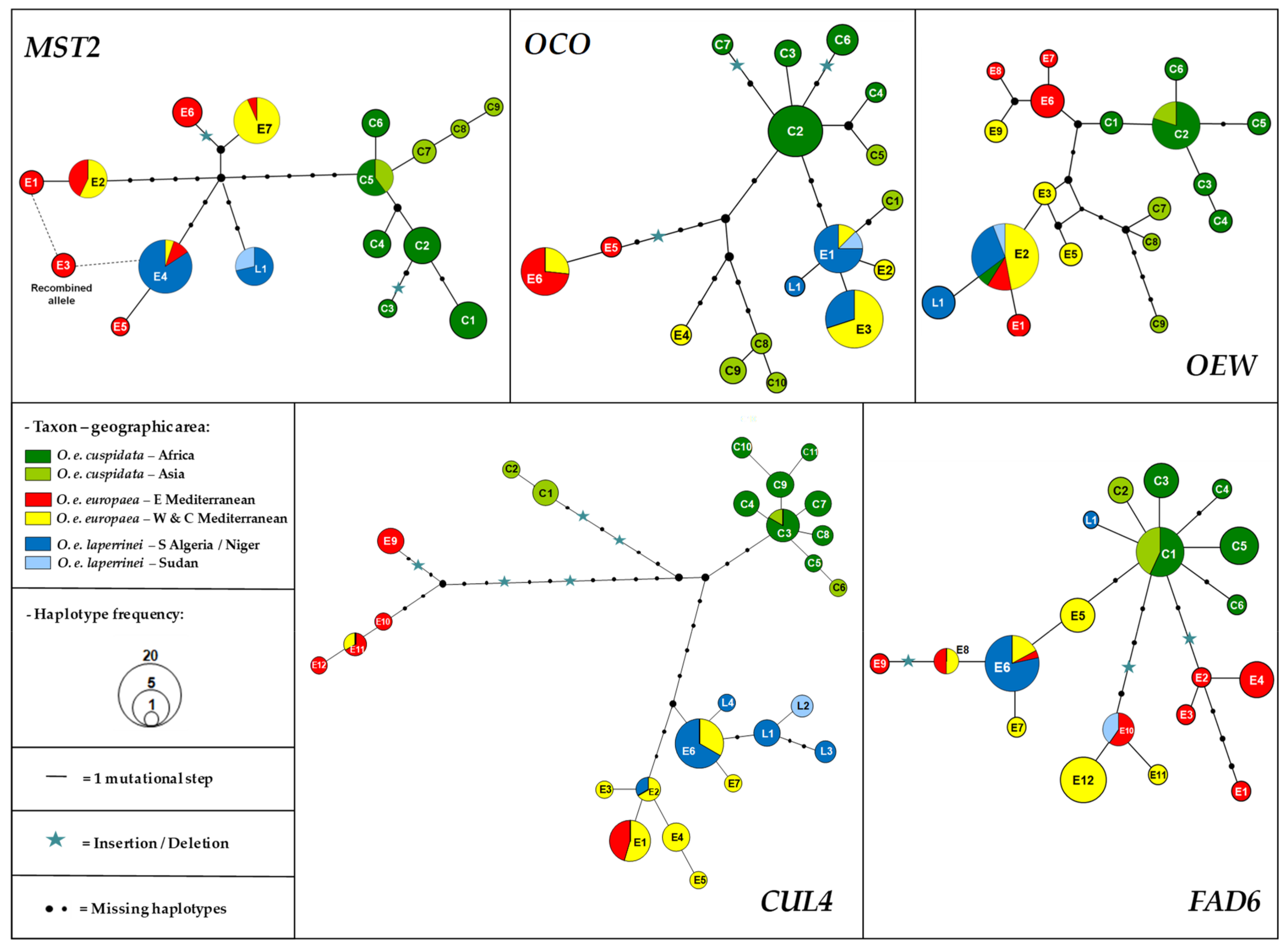
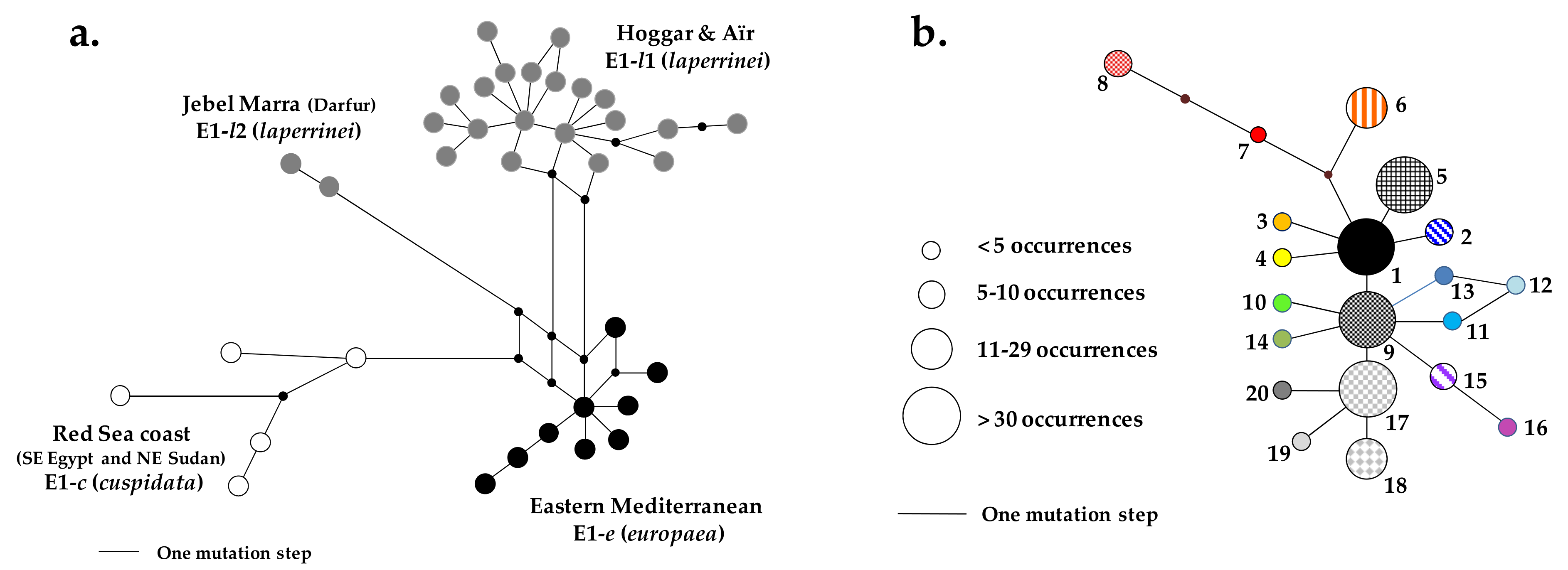
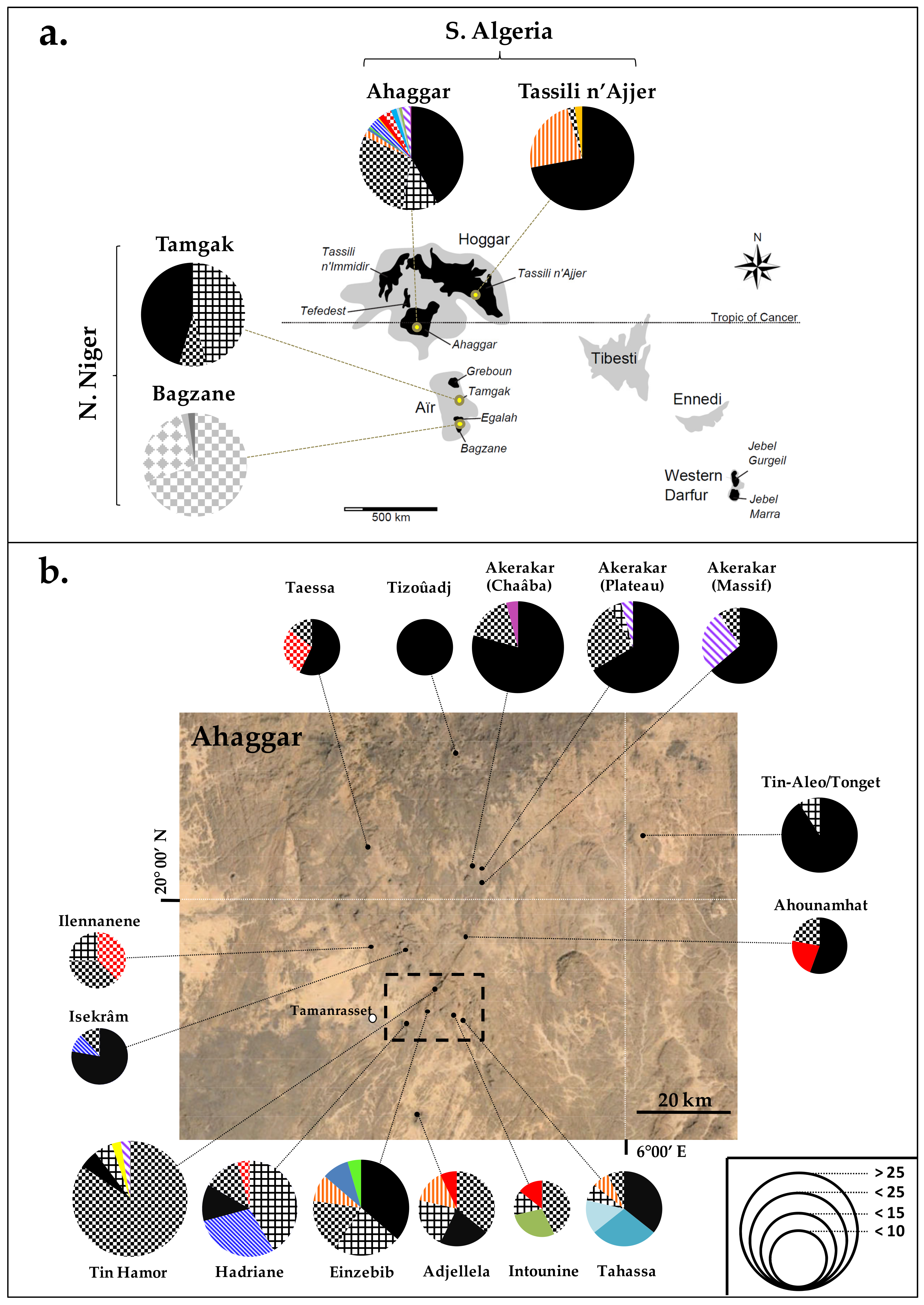
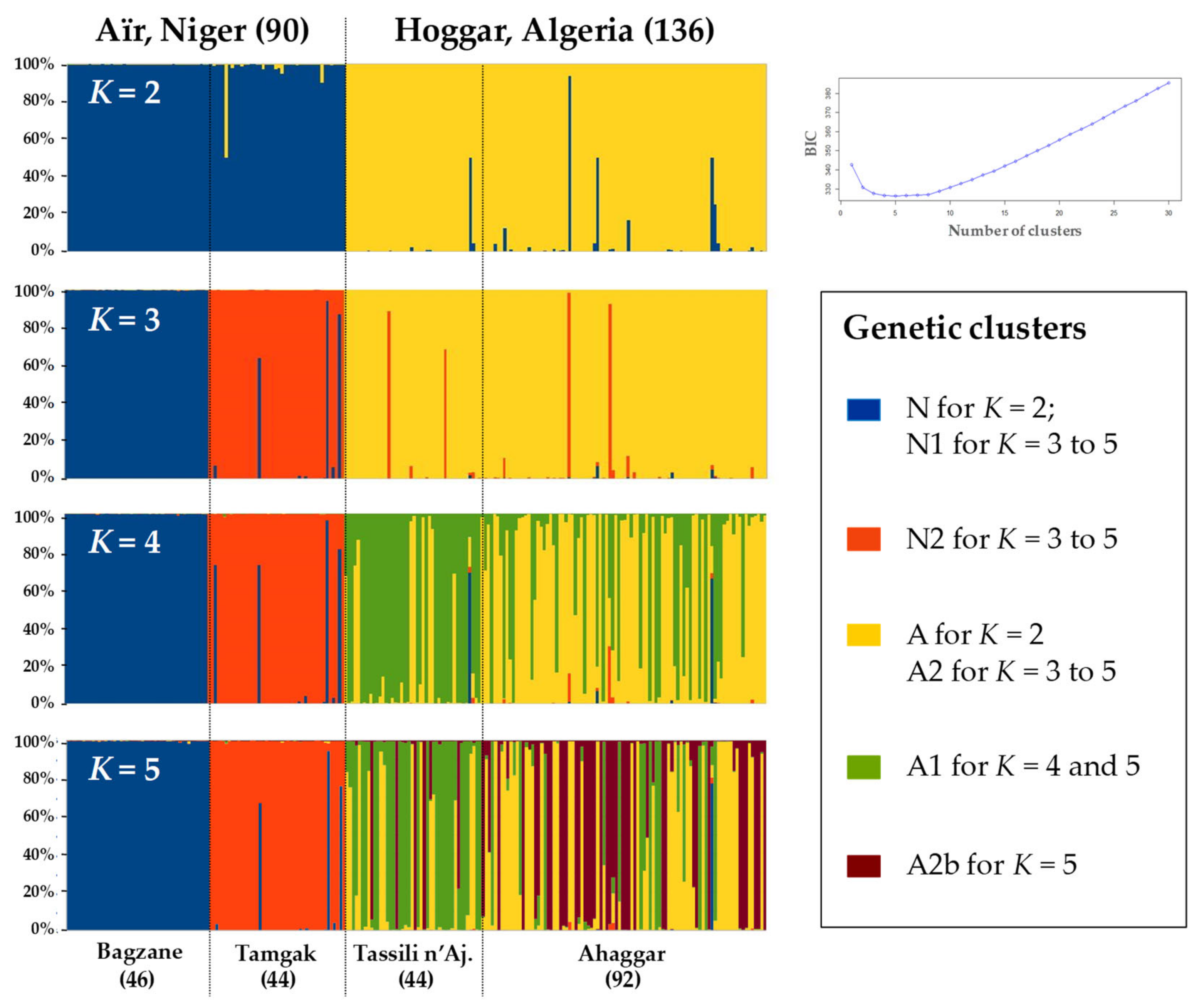
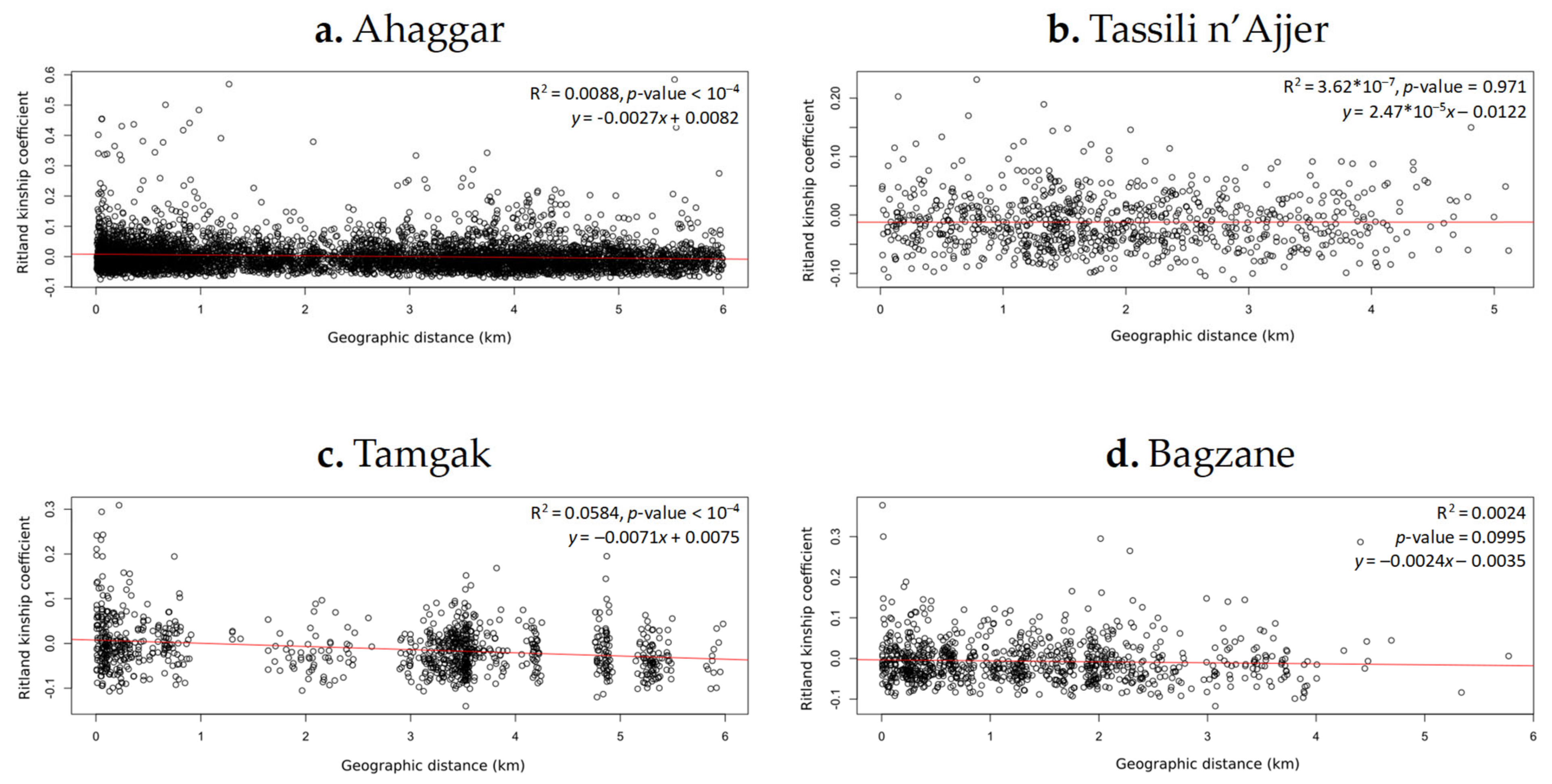
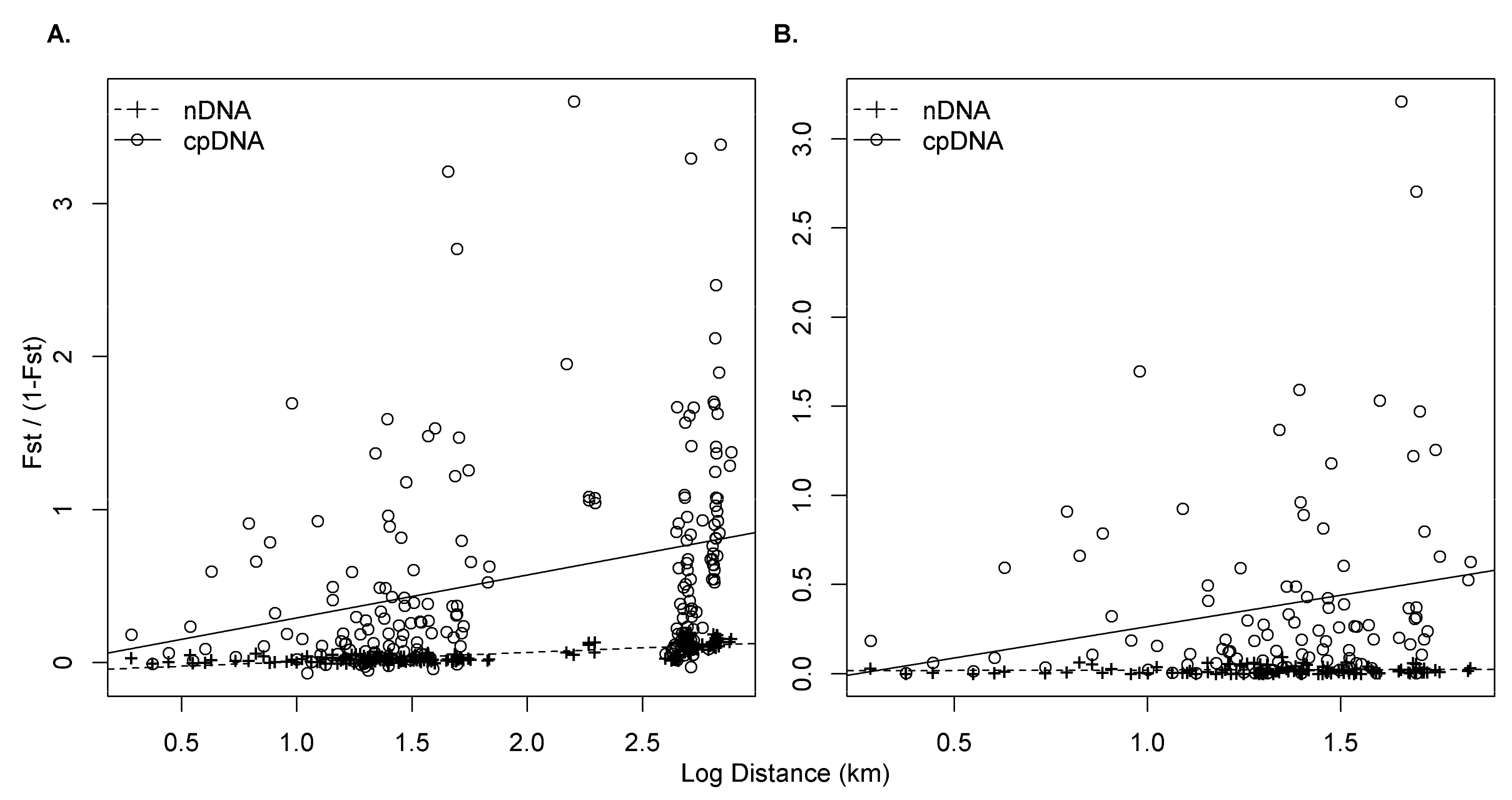
| Taxa | n | Locus | Mean | ||||
|---|---|---|---|---|---|---|---|
| MST2 | OCO | OEW | CUL4 | FAD6 | |||
| Subsp. laperrinei | 21 | 0.373 ± 0.162 | 0.076 ± 0.056 | 0.099 ± 0.100 | 0.144 ± 0.063 | 0.260 ± 0.101 | 0.179 ± 0.090 |
| Subsp. europaea | 34 | 0.766 ± 0.261 | 0.798 ± 0.209 | 0.521 ± 0.155 | 1.021 ± 0.200 | 0.732 ± 0.243 | 0.798 ± 0.212 |
| Subsp. cuspidata | 26 | 0.520 ± 0.167 | 0.443 ± 0.105 | 0.817 ± 0.198 | 0.390 ± 0.105 | 0.200 ± 0.081 | 0.459 ± 0.126 |
| All three taxa | 81 | 1.393 ± 0.325 | 0.717 ± 0.195 | 0.799 ± 0.196 | 1.007 ± 0.187 | 0.603 ± 0.181 | 0.899 ± 0.210 |
| Massif | Ahaggar | Tassili n’Ajjer | Tamgak | |||
|---|---|---|---|---|---|---|
| nDNA | cpDNA | nDNA | cpDNA | nDNA | cpDNA | |
| Tassili n’Ajjer | 2.5 * | 13.1 * | ||||
| Tamgak | 9.1 * | 9.4 * | 8.8 * | 23.4 * | ||
| Bagzane | 9.8 * | 37.2 * | 11.9* | 55.4 * | 8.1 * | 47.7 * |
| Subspecies | Geographic Area | Npops | FSTc | FSTn | FIS | R |
|---|---|---|---|---|---|---|
| laperrinei | Central Sahara | 21 | 0.376 | 0.061 | −0.002 | 6.37 |
| Ahaggar | 15 | 0.294 | 0.017 | −0.019 | 17.08 | |
| Adrar Heggueghene | 5 | 0.319 | 0.012 | −0.001 | 33.28 | |
| europaea | Whole Mediterranean Basin | 45 | 0.499 | 0.098 | −0.012 | 7.06 |
| Western part | 15 | 0.545 | 0.061 | −0.012 | 16.22 | |
| Central part | 13 | 0.719 | 0.057 | −0.008 | 39.99 | |
| Eastern part | 17 | 0.375 | 0.066 | −0.015 | 6.36 |
Publisher’s Note: MDPI stays neutral with regard to jurisdictional claims in published maps and institutional affiliations. |
© 2021 by the authors. Licensee MDPI, Basel, Switzerland. This article is an open access article distributed under the terms and conditions of the Creative Commons Attribution (CC BY) license (https://creativecommons.org/licenses/by/4.0/).
Share and Cite
Besnard, G.; Gorrilliot, O.; Raimondeau, P.; Génot, B.; El Bakkali, A.; Anthelme, F.; Baali-Cherif, D. Contrasting Genetic Footprints among Saharan Olive Populations: Potential Causes and Conservation Implications. Plants 2021, 10, 1207. https://doi.org/10.3390/plants10061207
Besnard G, Gorrilliot O, Raimondeau P, Génot B, El Bakkali A, Anthelme F, Baali-Cherif D. Contrasting Genetic Footprints among Saharan Olive Populations: Potential Causes and Conservation Implications. Plants. 2021; 10(6):1207. https://doi.org/10.3390/plants10061207
Chicago/Turabian StyleBesnard, Guillaume, Océane Gorrilliot, Pauline Raimondeau, Benoit Génot, Ahmed El Bakkali, Fabien Anthelme, and Djamel Baali-Cherif. 2021. "Contrasting Genetic Footprints among Saharan Olive Populations: Potential Causes and Conservation Implications" Plants 10, no. 6: 1207. https://doi.org/10.3390/plants10061207
APA StyleBesnard, G., Gorrilliot, O., Raimondeau, P., Génot, B., El Bakkali, A., Anthelme, F., & Baali-Cherif, D. (2021). Contrasting Genetic Footprints among Saharan Olive Populations: Potential Causes and Conservation Implications. Plants, 10(6), 1207. https://doi.org/10.3390/plants10061207






